
The Minnesota Senate is the upper house of the Legislature of the U.S. state of Minnesota. At 67 members, half as many as the Minnesota House of Representatives, it is the largest upper house of any U.S. state legislature. Floor sessions are held in the west wing of the State Capitol in Saint Paul. Committee hearings, as well as offices for senators and staff, are located north of the State Capitol in the Minnesota Senate Building. Each member of the Minnesota Senate represents approximately 80,000 constituents.

The California State Legislature is a bicameral state legislature consisting of a lower house, the California State Assembly, with 80 members; and an upper house, the California State Senate, with 40 members. Both houses of the Legislature convene at the California State Capitol in Sacramento. The California state legislature is one of just ten full-time state legislatures in the United States. The houses are distinguished by the colors of the carpet and trim of each house. The Senate is distinguished by the color red and the Assembly by the color green, inspired by the United Kingdom's House of Lords and House of Commons respectively.

The Michigan Legislature is the legislature of the U.S. state of Michigan. It is organized as a bicameral body composed of an upper chamber, the Senate, and a lower chamber, the House of Representatives. Article IV of the Michigan Constitution, adopted in 1963, defines the role of the Legislature and how it is to be constituted. The chief purposes of the Legislature are to enact new laws and amend or repeal existing laws. The Legislature meets in the Capitol building in Lansing.

The Florida Legislature is the legislature of the U.S. state of Florida. It is organized as a bicameral body composed of an upper chamber, the Senate, and a lower chamber, the House of Representatives. Article III, Section 1 of the Florida Constitution, adopted in 1968, defines the role of the legislature and how it is to be constituted. The legislature is composed of 160 state legislators. The primary purpose of the legislature is to enact new laws and amend or repeal existing laws. It meets in the Florida State Capitol building in Tallahassee.

The California State Senate is the upper house of the California State Legislature, the lower house being the California State Assembly. The state senate convenes, along with the state assembly, at the California State Capitol in Sacramento.
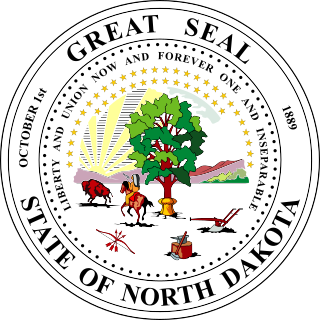
The North Dakota Senate is the upper house of the North Dakota Legislative Assembly, smaller than the North Dakota House of Representatives.

The Hawaii State Senate is the upper house of the Hawaii State Legislature. It consists of twenty-five members elected from an equal number of constituent districts across the islands and is led by the President of the Senate, elected from the membership of the body, currently Ron Kouchi. The forerunner of the Hawaii Senate during the government of the Kingdom of Hawaii was the House of Nobles originated in 1840. In 1894, the Constitution of the Republic of Hawaii renamed the upper house the present senate. Senators are elected to four-year terms and are not subject to term limits.
Since Montana became a U.S. state in 1889, it has sent congressional delegations to the United States Senate and the United States House of Representatives. Each state elects two senators to serve for six years. Before the Seventeenth Amendment took effect in 1913, senators were elected by the Montana State Legislature. Members of the House of Representatives are elected to two-year terms, one from Montana's at-large congressional district. Before becoming a state, the Territory of Montana elected a non-voting delegate at-large to Congress from 1864 to 1889.

The South Carolina Senate is the upper house of the South Carolina General Assembly, the lower house being the South Carolina House of Representatives. It consists of 46 senators elected from single member districts for four-year terms at the same time as United States presidential elections.
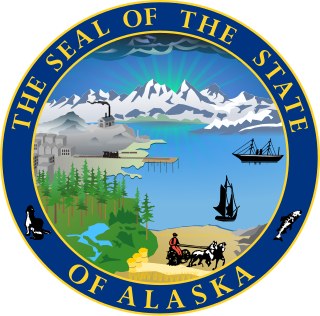
The Alaska State Senate is the upper house in the Alaska State Legislature, the state legislature of the U.S. state of Alaska. It convenes in the Alaska State Capitol in Juneau, Alaska and is responsible for making laws and confirming or rejecting gubernatorial appointments to the state cabinet, commissions and boards.

The Iowa General Assembly is the legislative branch of the state government of Iowa. Like the federal United States Congress, the General Assembly is a bicameral body, composed of the upper house Iowa Senate and the lower Iowa House of Representatives respectively. The Senate consists of four year terms and the House consists of two year terms. The General Assembly convenes within the Iowa State Capitol in Des Moines since the capital was moved there in 1857. The assembly convenes annually on the second Monday in January.

The Arizona State Legislature is the state legislature of the U.S. state of Arizona. It is a bicameral legislature that consists of a lower house, the House of Representatives, and an upper house, the Senate. Composed of 90 legislators, the state legislature meets in the Capitol Complex in the state capital of Phoenix. Created by the Arizona Constitution upon statehood in 1912, the Arizona State Legislature met biennially until 1950. Today, they meet annually.

The Montana House of Representatives is, with the Montana Senate, one of the two houses of the Montana Legislature. Composed of 100 members, the House elects its leadership every two years.

The Kentucky Senate is the upper house of the Kentucky General Assembly. The Kentucky Senate is composed of 38 members elected from single-member districts throughout the Commonwealth. There are no term limits for Kentucky senators. The Kentucky Senate meets at the Kentucky State Capitol in Frankfort annually beginning in January. Sessions last for 60 legislative days in even-numbered years and 30 legislative days in odd-numbered years.

The Arizona State Senate is part of the Arizona Legislature, the state legislature of the US state of Arizona. The Senate consists of 30 members each representing an average of 219,859 constituents. Members serve two-year terms with term limits that limit Senators to a maximum four consecutive terms before requiring a one-term respite prior to running again. Members of the Republican Party are currently the majority in the Senate. There are currently 16 women serving in the Senate after Raquel Terán was appointed, making it the first time a majority of the body was composed of female members.

The Arizona State House of Representatives is the lower house of the Arizona Legislature, the state legislature of the U.S. state of Arizona. The upper house is the Senate. The House convenes in the legislative chambers at the Arizona State Capitol in Phoenix. Its members are elected to two-year terms, with a term limit of four consecutive terms. Each of the state's 30 legislative districts elects two state house representatives and one state senator, with each district having a population of at least 203,000.
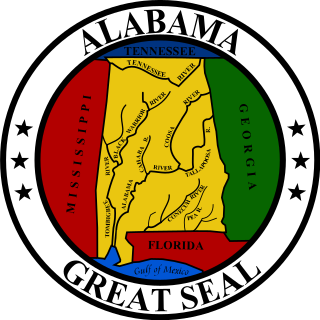
The Alabama State Senate is the upper house of the Alabama Legislature, the state legislature of the U.S. state of Alabama. The body is composed of 35 members representing an equal number of districts across the state, with each district containing at least 127,140 citizens. Similar to the lower house, the Alabama House of Representatives, the senate serves both without term limits and with a four-year term.
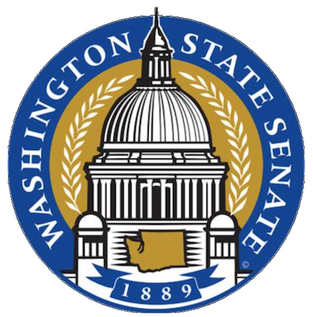
The Washington State Senate is the upper house of the Washington State Legislature. The body consists of 49 members, each representing a district with a population of nearly 160,000. The State Senate meets at the Legislative Building in Olympia.
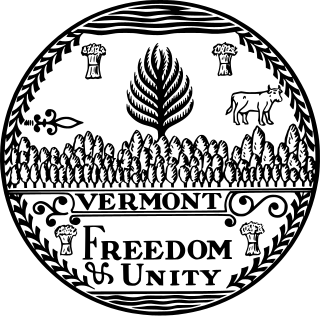
The Vermont Senate is the upper house of the Vermont General Assembly, the state legislature of the U.S. state of Vermont. The senate consists of 30 members elected from multi-member districts. Each senator represents at least 20,300 citizens. Senators are elected to two-year terms and there is no limit to the number of terms that a senator may serve.
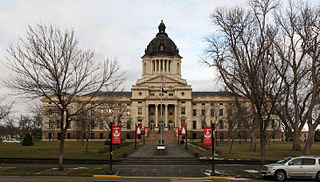
The structure of the government of South Dakota is based on that of the federal government, with three branches of government: executive, legislative, and judicial. The structure of the state government is laid out in the Constitution of South Dakota, the highest law in the state. The constitution may be amended either by a majority vote of both houses of the legislature, or by voter initiative.



















